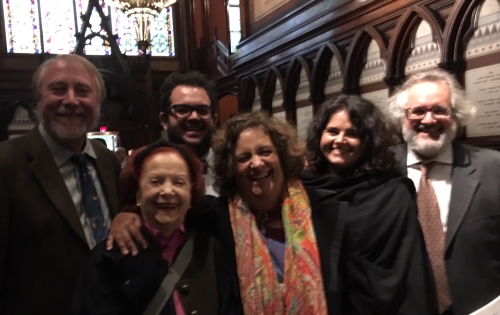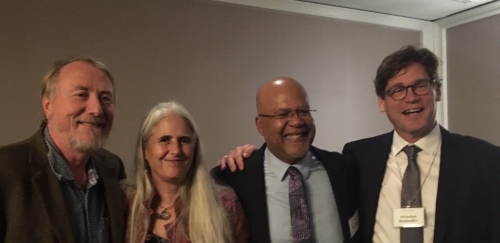I have been very fortunate to know and work with outstanding Black scientists throughout my career. Here are a few of them.
I met Joe Graves when we were undergraduates at Oberlin College. We took an evolution course together. I remember discussing with Joe our mutual fascination with evolution and wondering how we might go about studying it. I met up again with Joe at UC-Irvine, where we were both conducting evolution experiments—Joe using fruit flies, and me with bacteria. Joe and I reconnected once more when he and I became founding members of the BEACON Center for the Study of Evolution in Action. Joe now studies bacterial evolution, and we are becoming scientific collaborators as well.
JoAnn White was an ecologist at UNC, studying the life-history and population dynamics of periodical cicadas. She served on my doctoral advisory committee and was a highly successful faculty member. Unfortunately, she left academia, even though she had tenure, because it was too frustrating. I was honored that she asked me to write a reference letter when she moved to a new profession. But it was a terrible loss for academia to lose such an outstanding scientist and role model as JoAnn White.
Paul Turner was one of my first graduate students. He joined my lab in the Department of Ecology and Evolution at UC-Irvine, and he moved with me to MSU, receiving his Ph.D. in 1995. Paul has impressed me in many ways, not only as a superb scientist and mentor, but also in his upbeat outlook on life. Somehow he manages to smile and laugh about the challenges of being a departmental chair and interim dean, even while running a lab that conducts ground-breaking research.
Lynette Ekunwe was my lab manager and technician for seven years after I moved to MSU. She helped to sustain the long-term evolution experiment with E. coli after its move from UC-Irvine, and she helped run my lab group as it grew in size. Lynette moved to Jackson State University when her husband, the late Steve Ekunwe, took a faculty position there. After the move, Lynette earned a doctorate in public health, and she now works in the field of epidemiology.
I first met Scott Edwards when he was a graduate student at UC-Berkeley. I suspected that he was a rising star, and I was right. Although Scott and I have not collaborated on actual science, we’ve worked together in other ways. Scott and I served successive terms as Presidents of the Society for the Study of Evolution, and he has been a valued member of the External Advisory Board for the BEACON Center.
Shenandoah Oden was an undergraduate from Detroit when she joined my lab in the 1990s. She worked with postdoc Santiago Elena on measuring the fitness effects of random insertion mutations in E. coli, leading to a paper in Genetica. What I remember best about Shenandoah is a question she asked me right after Brendan Bohannan presented his dissertation seminar: “How do scientists come up with the questions they ask?” I told her that was the best question that any student had ever asked me. It reminded me of how Joe Graves and I, when we were undergrads, wondered how we might study evolution. To Shenandoah, I explained the importance of personal curiosity and mentors in finding questions that are both interesting and answerable.
Marwa Adewa, Maia Rowles and Kiyana Weatherspoon were three excellent undergraduate researchers in my lab, all of whom were mentored by Zachary Blount. Maia and Kiyana were coauthors on a paper in the Proceedings of the Royal Society, London B, which reported the results of what we call the “all-hands project”—one in which a generation of lab members performed a set of parallel assays to measure the subtle changes in fitness in late generations of the long-term evolution experiment with E. coli. Marwa now works in the field of veterinary medical research, while Maia and Kiyana are pursuing careers with a biomedical focus.
Judi Brown Clarke was, until very recently, the Diversity Director for our BEACON Center. In that role she generated and managed many successful programs that introduced hundreds of students at all levels to evolution and provided them with opportunities to engage in scientific research. She also was a great listener and valuable source of advice for many of us when we faced personal challenges and setbacks. An Olympic medalist, Judi recently became the Chief Diversity Officer at Stony Brook University.
I met Jay Bundy in 2013, at the Evolution meeting in Snowbird, Utah. Who was this student who was asking so many thoughtful, insightful questions of the speakers? I ran into Jay as we rushed between talks, introduced myself, and learned that he was a masters student at Penn State. He wasn’t sure if he was interested in microbes, but I encouraged him to think about joining BEACON. Jay came to MSU, first as a BEACON staff member contributing to education and outreach activities, and then as a graduate student in the Department of Integrative Biology. He also contributed to the all-hands project. However, he switched from studying bacteria to digital organisms, and he’s now performing and analyzing experiments to quantify how the duration of history in an evolving lineage’s previous environment influences its subsequent evolution in a new environment. Stay tuned for Jay’s findings—he’s working on a huge paper. Jay is as deeply thoughtful about science and life as I imagined when I first heard his questions at the Evolution meeting.
I also met Nkrumah Grant in 2013, when he visited MSU while exploring possible graduate programs. He immediately impressed me with his personal story of overcoming obstacles. Nkrumah explained to me his love of science as a child, and how he had gotten discouraged and derailed before undertaking a concerted effort to pursue his dream of science and scholarship. And pursue it he did … and continues to do. From a G.E.D. to a Ph.D. Co-author on the all-hands project, co-first-author on a paper just published in eLife, and three more papers posted to bioRxiv in the last few weeks. He also just defended his dissertation, giving a beautiful public seminar followed by an engaging, collegial exam. Nkrumah has done all this and more while being a dedicated father and working tirelessly to promote equity and inclusion in science.
Last but not least, Ali Abdel Magid and Jalin Jordan are two of the current generation of superb undergraduate researchers in the lab. Ali is working with Nkrumah on the evolution of bacterial cell size, while Jalin works with Kyle Card on the evolution of antibiotic resistance. Both Ali and Jalin are also working toward future careers in medicine. This summer, they are reading work that integrates evolution and medicine including the landmark book, Why We Get Sick, by Nesse and Williams, and the path-breaking paper by Tami Lieberman et al. on the evolution of bacteria in the lungs of CF patients.
My science is better, and my life richer, because of all these people, and many more. How much better science would be, and how much richer all of our lives would be, if we would open more doors, listen more carefully, and live, learn, and work together.
***
After reading a draft of this essay, Nkrumah Grant, Joe Graves, and Jay Bundy all asked me to say more about this: How can we achieve the aspirations expressed in my closing sentence above?
I plan to reflect more on their vital question. In the meantime, I invite readers who have ideas to put them in the comments below.
EDIT: I should also acknowledge two other influences: A high-school teacher, Mrs. Clayton, who taught a Black History class that I took, and who introduced me to Frederick Douglass, whose autobiography I read with awe and admiration.












